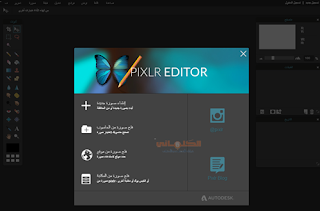
NVTT: Adds nvtt::Surface::gpuDataMutable().In particular, this can be used to detect errors even when a function does not return bool. NVTT now reports errors, warnings, and messages through each thread's message callback. NVTT: Adds nvtt::SetMessageCallback().NVTT: Adds 16-bit half float (nvtt::ValueType::FLOAT16) as an input to the low-level API.NVTT: Adds precompiled kernels for Hopper and Ada GPUs.Exporter standalone: Interprets ICC v4 color profiles that can't be transformed as linear instead of crashing.Exporter standalone: Improvements to FreeImage security.

exr files would load blank unless that component was named "Y".
#PIXLR TRANSPARENT LOGO MAKER WINDOWS#
Exporter: Modifies window creation to support Windows Sandbox and Remote Desktop.Exporter: Fixes a bug where BC7 was listed twice as an export format.Exporter: Fixes a bug where the blue component of tangent-space normals used the entire range instead of.Exporter: Statically links with runtime libraries to remove MSVC++ Runtime Library installation requirement.

Exporter: Adds Ctrl-S and Ctrl-O shortcuts for Save and Open.Exporter: Adds linear-to-sRGB and sRGB-to-linear effects.Exporter: Adds support for volume textures and texture arrays.Preset files from the legacy plugin can also be loaded in the current plugin and standalone. Exporter: Adds ability to save and load settings in presets.Exporter: Improves OpenGL compatibility by removing usage of glGetTextureLevelParameteriv().Exporter: Fixes a bug where DDS cube maps were written with an arraySize 6x the correct number.NVTT: Fixes a bug where the CPU BC1 compressor would sometimes encode transparent single-color blocks with transparency.NVTT: Faster compression when using the nvtt::Context API and the nvtt::Surface data is not in VRAM.These variants of Surface::load() and Surface::save() work on in-memory data. NVTT: Adds Surface::loadFromMemory(), Surface::saveToMemory(), and CubeSurface::loadFromMemory().For instance, game developers can use this to reduce the size of the games they create - or realistic rendering and digital content creation developers can use this to fit higher-resolution textures in memory.

These tools are ideal for artists and graphics engineers looking to save texture memory and reduce the size of their applications or fit more or higher-resolution textures into the same space. NVIDIA Texture Tools Exporter standalone showcasing a cube map reflection A new compression preview pane allows you to see how your image will be compressed in real-time, without having to write to disk. This exporter combines four texture tools in a single plugin and standalone application, including flexible and powerful support for cube maps, mipmaps, normal maps, transparency, and more than 130 import formats.
#PIXLR TRANSPARENT LOGO MAKER FULL#
Select "PNG (Transparent, full quality)" from the "Format" drop-down list and click "OK" to save the transparent photo.The NVIDIA Texture Tools Exporter allows users to create highly compressed texture files - that stay small both on disk and in memory - directly from image sources using NVIDIA’s CUDA-accelerated Texture Tools 3.0 compressor technology. The white and grey squares on the new image indicate the areas that are transparent.Ĭlick "File" from the Menu bar and select "Save" or use the "Ctrl-S" shortcut keys. Select "Clipboard" from the "Presets" drop-down list and click the check boxes next to both "Create image from Clipboard" as well as "Transparent."Įnter a title for the new image in the "Name" section and then click the "OK" button. Alternatively, uncheck the "Contiguous" check box at the top of the screen to add all pixels in the image that match your selection.Ĭlick "Edit" from the Menu bar and select "Invert selection" from the list of options.Ĭlick "Edit" from the Menu bar and select "Copy" or press "Ctrl-C" to copy the image to the clipboard.Ĭlick "File" from the Menu bar and select "New Image" or use the "Ctrl-N" shortcut keys. Hold down the "Shift" key and click another region of the photo to add it to the selection. Click and drag the "Tolerance" slider at the top of the screen to expand the selection outline. Click "Open image from computer" and then select the photo that you want to modify.Ĭlick the "Wand" tool from the tools palette on the left or press "W" and then click the area of the photo that you want to make transparent.


 0 kommentar(er)
0 kommentar(er)
